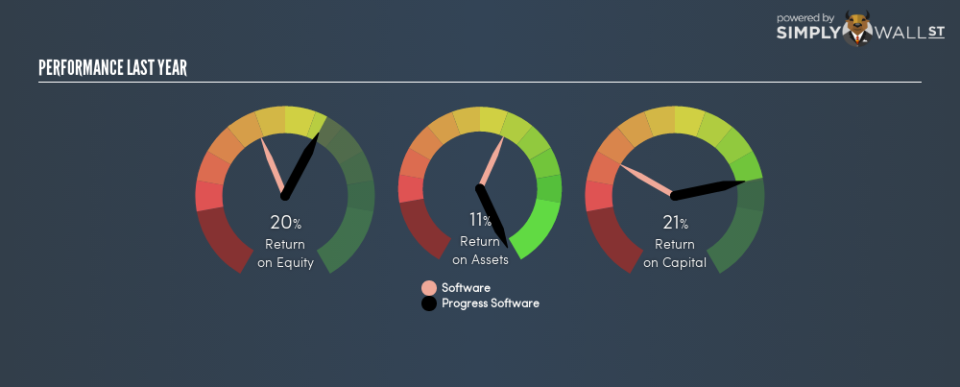Progress Software Corporation (NASDAQ:PRGS) Earns Among The Best Returns In Its Industry

Today we are going to look at Progress Software Corporation (NASDAQ:PRGS) to see whether it might be an attractive investment prospect. To be precise, we’ll consider its Return On Capital Employed (ROCE), as that will inform our view of the quality of the business.
First of all, we’ll work out how to calculate ROCE. Next, we’ll compare it to others in its industry. Finally, we’ll look at how its current liabilities affect its ROCE.
Return On Capital Employed (ROCE): What is it?
ROCE is a measure of a company’s yearly pre-tax profit (its return), relative to the capital employed in the business. All else being equal, a better business will have a higher ROCE. Ultimately, it is a useful but imperfect metric. Renowned investment researcher Michael Mauboussin has suggested that a high ROCE can indicate that ‘one dollar invested in the company generates value of more than one dollar’.
So, How Do We Calculate ROCE?
The formula for calculating the return on capital employed is:
Return on Capital Employed = Earnings Before Interest and Tax (EBIT) ÷ (Total Assets – Current Liabilities)
Or for Progress Software:
0.21 = US$95m ÷ (US$641m – US$196m) (Based on the trailing twelve months to November 2018.)
So, Progress Software has an ROCE of 21%.
Check out our latest analysis for Progress Software
Want to help shape the future of investing tools and platforms? Take the survey and be part of one of the most advanced studies of stock market investors to date.
Is Progress Software’s ROCE Good?
When making comparisons between similar businesses, investors may find ROCE useful. Progress Software’s ROCE appears to be substantially greater than the 9.5% average in the Software industry. We consider this a positive sign, because it suggests it uses capital more efficiently than similar companies. Regardless of the industry comparison, in absolute terms, Progress Software’s ROCE currently appears to be excellent.
In our analysis, Progress Software’s ROCE appears to be 21%, compared to 3 years ago, when its ROCE was 4.8%. This makes us think about whether the company has been reinvesting shrewdly.
When considering ROCE, bear in mind that it reflects the past and does not necessarily predict the future. Companies in cyclical industries can be difficult to understand using ROCE, as returns typically look high during boom times, and low during busts. ROCE is only a point-in-time measure. Future performance is what matters, and you can see analyst predictions in our free report on analyst forecasts for the company.
What Are Current Liabilities, And How Do They Affect Progress Software’s ROCE?
Liabilities, such as supplier bills and bank overdrafts, are referred to as current liabilities if they need to be paid within 12 months. Due to the way ROCE is calculated, a high level of current liabilities makes a company look as though it has less capital employed, and thus can (sometimes unfairly) boost the ROCE. To check the impact of this, we calculate if a company has high current liabilities relative to its total assets.
Progress Software has total liabilities of US$196m and total assets of US$641m. As a result, its current liabilities are equal to approximately 31% of its total assets. Progress Software’s ROCE is boosted somewhat by its middling amount of current liabilities.
Our Take On Progress Software’s ROCE
Despite this, it reports a high ROCE, and may be worth investigating further. You might be able to find a better buy than Progress Software. If you want a selection of possible winners, check out this free list of interesting companies that trade on a P/E below 20 (but have proven they can grow earnings).
If you like to buy stocks alongside management, then you might just love this free list of companies. (Hint: insiders have been buying them).
To help readers see past the short term volatility of the financial market, we aim to bring you a long-term focused research analysis purely driven by fundamental data. Note that our analysis does not factor in the latest price-sensitive company announcements.
The author is an independent contributor and at the time of publication had no position in the stocks mentioned. For errors that warrant correction please contact the editor at editorial-team@simplywallst.com.

 Yahoo Finance
Yahoo Finance 
